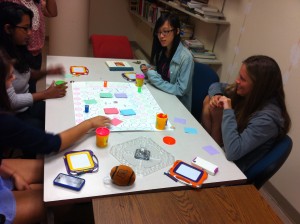Multitasker is a board game designed to teach students about the bottleneck that occurs in decision making by allowing them to experience the process firsthand. Players are challenged with up to four physical tasks that must be accomplished simultaneously within a time limit. Initial play testing showed that the game was fun, and students were getting acquainted with the idea that multitasking is more challenging than they originally appreciated.
Of all the games in development during this summer research project, Multitasker has posed the fewest design problems. The core game mechanic is closely wedded to the lesson being learned, which is critical in educational game design. There were only a few adjustments that needed to be made during the second iteration of prototyping, and we are on our way toward collecting pilot data. The student designer developed a new board that served as the centerpiece for the game. Apart from providing players with feedback on their progress in the game, the board was a critical addition because it was the means of controlling flow. Previously, we were using the roll of a four-sided die to determine how many tasks a player would perform simultaneously. The problem was that a player could roll a 4 on their first round of play and be immediately challenged with four tasks. This method was a rather poor way of controlling flow. Now, the player rolls a die to move between four stations on the board. Players move forward or backward on the board depending on whether they succeed or fail on a given task, respectfully. Essentially, the game incorporates a 1-up/1-down psychophysical staircase. An additional task is added when a player makes it to the next station. This way, players have a chance to practice several tasks individually before additional tasks are added. Each player starts from their own station, and the goal of the game is to make it through all four stations. The number of steps between stations is graded so that players have a lot of time to practice individual tasks, but they only have a few trials where they have to do all four tasks at once. Apart from the board, we added an audible egg timer to insure that players could hear when time was running out. And the student designer found travel-sized MagnaDoodle boards that made drawing with one hand possible.
Finally, the student designer had to develop appropriate methods for assessing the efficacy of her game. Before and after attitude surveys toward multitasking were created. We believe these surveys are a valid method of assessment because we are mostly concerned with the students’ attitudes about multitasking rather than their ability to multitask, even though in-game assessment of performance is major advantage of games. Eventually, experimental and control groups will be compared on the survey. We predict that students who play the game will have a more accurate view of multitasking compared to students who learn about multitasking via written text. Survey questions prompted subjects about the likelihood of completing certain tasks simultaneously. Surveys were constructed using the split-half reliability method. Player attitudes were recorded using Likert scales.
The primary lesson to be learned from our experience with Multitasker is to think small. If you manage to find a simple lesson to teach, it is far easier to find an appropriate game mechanic to teach that lesson.



